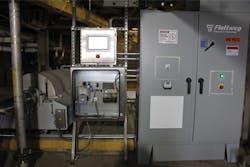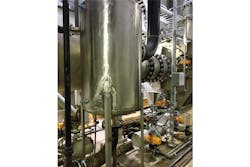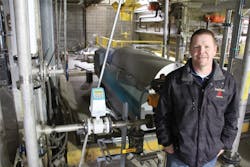Separation technology boosts bourbon production at historic Kentucky distillery
Rich in tradition and history, this 130-year-old company decided in 2015 to embark on a plant expansion that would double its capacity from 4 million proof gallons to 8 million proof gallons per year. The decision for the expansion was based on increasing and projected industry growth. But doubling capacity would not be easy. Among other things, it would require upgrading to a sophisticated centrifuge system to boost volume and efficiency.
The history
Nestled on the scenic Salt River in Lawrenceburg, Kentucky — deep in the heart of bourbon country — sits a unique distillery with Spanish mission-style architecture. Four Roses Distillery began producing bourbon on this site in 1910 and houses its single-story rack warehousing and bottling operation in the quiet countryside at Cox’s Creek.
Four Roses handcrafts 10 distinct bourbon recipes and is one of the largest bourbon manufacturers in Kentucky, a state that produces 95 percent of the world’s bourbon supply.
Four Roses is the only bourbon distillery that combines five proprietary yeast strains with two separate mashbills to handcraft its bourbon recipes, each with its own character, spiciness and rich fruity flavors. Up to all 10 recipes are mingled by hand to create Four Roses Bourbon.
This Flottweg technology eliminates the need for a backup system or spare parts.
Bourbon is big business. It is an $8.5 billion signature industry in Kentucky, generating 17,500 jobs with an annual payroll of $800 million, according to the Kentucky Distiller’s Association’s (KDA) January 2017 report, "The Economic and Fiscal Impacts of the Distilling Industry in Kentucky."
Spirits production and consumption pours more than $825 million in federal, state and local tax coffers every year, and more than $1.1 billion in capital projects have been completed or are planned and underway from 2012 through 2020, including new distilleries and aging warehouses to bottling facilities and tourism centers.
Kentucky’s iconic bourbon distilleries filled 1,886,821 barrels of bourbon in 2016, breaking production records all the way back to 1967, according to the report.
If the distilling industry in Kentucky continues to grow in the future as it has over the past seven years, by 2020 the employment impact should exceed 20,000, payroll $1 billion and output $10 billion, according to the report. State tax revenues from industry-related activities should approach $200 million by 2020 and local tax revenues should approach $42 million.
The challenge
With the massive plant expansion and challenge of doubling its capacity, Four Roses needed separation technology that would increase throughput, decrease waste and improve efficiency. Its previous system was outdated. The company was also working with a supplier that was not local and a system that required regular maintenance with inefficient downtime to wait for spare parts.
"At times we were waiting for weeks for service or for parts," said Dustin Goodlett, senior manager of operations. "The system was outdated. It was not automated, and it was not user friendly. We knew that we would need all these benefits if we wanted to accomplish our goal of doubling capacity."
The solution
In December 2017, Four Roses installed a Flottweg Separation Technology Z5E 4/454 DDGS Decanter centrifuge system.
"Just two months in, I already see a lot of benefits," Goodlett said. "In the past, we have had to invest lots of money into our centrifuge for rebuilds and preventive maintenance. So far, we are very satisfied with the Flottweg system."
In the Four Roses distillation process, the cook is made and then placed into a fermenter. Then the yeast is added. This process converts starches and sugars to alcohol. The alcohol is then sent to a beer still with the grain and other elements still in it. It is then sent to a beer still where the alcohol is stripped out. What is left over is the byproduct, or stillage.
"The stillage is then sent directly to the centrifuge, or actually the holding tank, and then to the centrifuge," Goodlett said. "The centrifuge will take out the solids and the amount of the liquid that comes off of that is what goes to the evaporator. The grain portion, or solid portion, is what goes to wet cake or to dry feed, or whatever it may be. In our application, it goes to wet cake. The evaporator removes the liquid portion of it, and the centrifuge takes out the solid. The solid stuff goes into the alder, and the thin stuff goes into another tank to evaporate the liquid and turns it into syrup. It is then applied back to the dryness that comes off the centrifuge."
Four Roses Distillery began producing bourbon on this site in 1910.
Goodlett said that without this process, Four Roses cannot produce its product 10 hours each day. "The centrifuge keeps us processing the by-product so that our tanks don’t fill up, and we don’t have to shut down the stills," he said.
When the plant reaches double capacity, the centrifuge will be running 24 hours per day, seven days a week.
Goodlett said that the new system allowed Four Roses to eliminate the need to have a backup system or to keep spare parts on hand.
The manufacturer maintains $5 million in spare parts at its Independence, Kentucky, location, two hours away.
Goodlett said one of the simplest parts of the Four Roses expansion has been installing the centrifuge system. "The start up has gone off without a hitch," he said. "It has been pretty painless. I’m really happy with this system."
Goodlett said another advantage has been that the centrifuge technology maximized the solid removal, and this has taken stress away from the evaporators. "There is very little maintenance, and it has the automatic clean-in-place (CIP) feature," he said. "The centrifuge will remove particles down to about 20 to 25 microns, depending on the density of the particles."
How it works
Decanter centrifuges are used for separating the whole stillage solids from the liquids. This process step is required because the evaporation and drying systems cannot handle whole stillage as a homogenous mixture. The whole stillage is pumped into the decanter centrifuge through a stationary feed tube. The feed stream enters from the center of the decanter. It is delivered through ports into the rotating bowl and is accelerated to the rotational speed. The centrifugal force generated can be greater than 3,500 "G" in some cases.
Four Roses Senior Manager of Operations Dustin Goodlett began to see benefits just two months after installing the Flottweg centrifuge system.
This centrifugal force is used to separate the different density components against the bowl wall. Solids are denser (heavier) and therefore slung to the bowl wall first. The liquid phase is not as dense (lighter) and ponds near the center of the decanter rotating assembly behind weirs (dam plates). The liquid phase simply discharges over the dam plates while the solids are conveyed in the opposite direction via a scroll (screw conveyor) located inside the rotating bowl. The scrolls’ rotational speed can be adjusted to deliver a controlled and continuous output to maximize the solids discharge quality. The weirs too can be adjusted to create tailored pond depths to provide excellent recovery opportunities that further support downstream systems.
The results
A better price point and ease of use have been other advantages of the centrifuge system, Goodlett said. "We keep our operator downstairs, and the centrifuge is upstairs," he said. "The only thing he has to come up for is to start and stop the machine — and that is mainly a safety precaution.
"So far, we are very happy with the machine and happy with the customer service. We are able to process our byproduct quicker and in a more efficient manner to keep our stills running. The machine is very user friendly. So far, it’s been very low maintenance."
Christian Pettit is the sales manager for Brewing, Distilled Spirits and Wine for Flottweg Separation Technology Inc. He holds a mechanical engineering degree and has 14 years of centrifuge experience, including stints in the service department, process engineering and sales. Pettit can be reached at [email protected].


